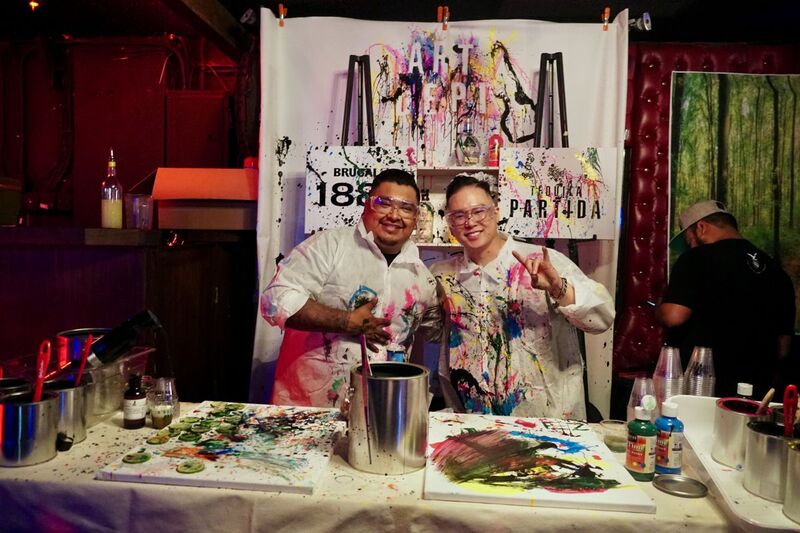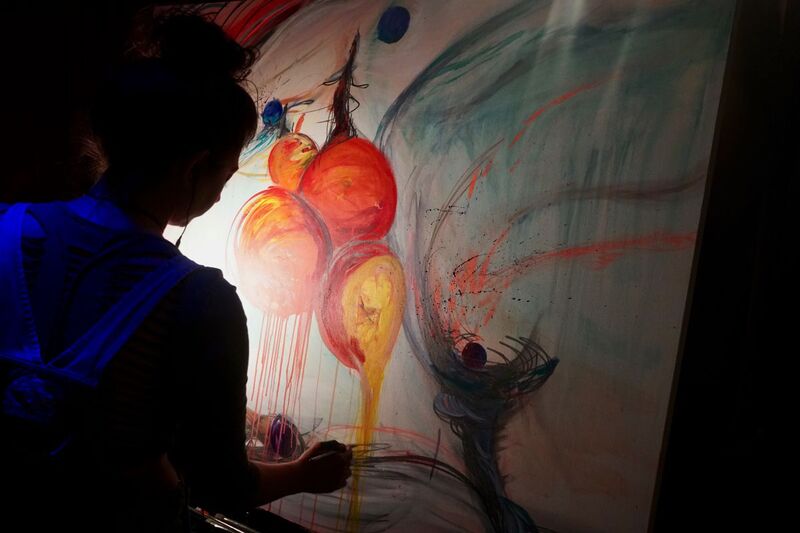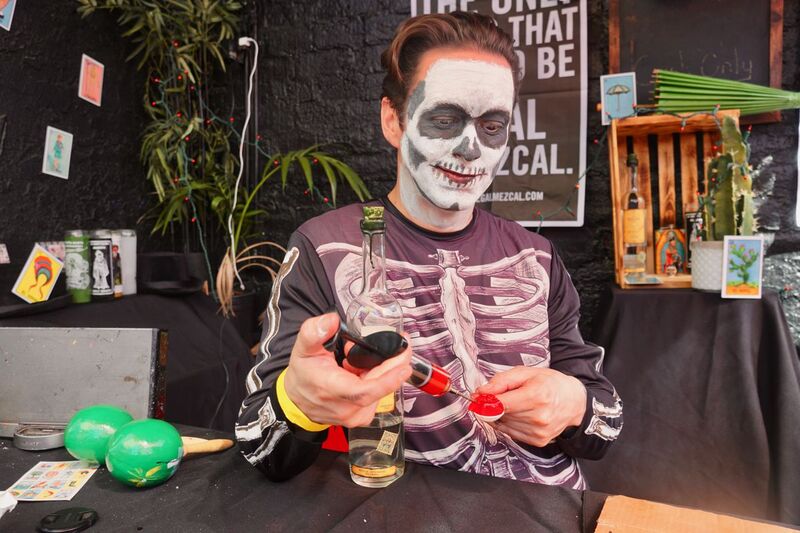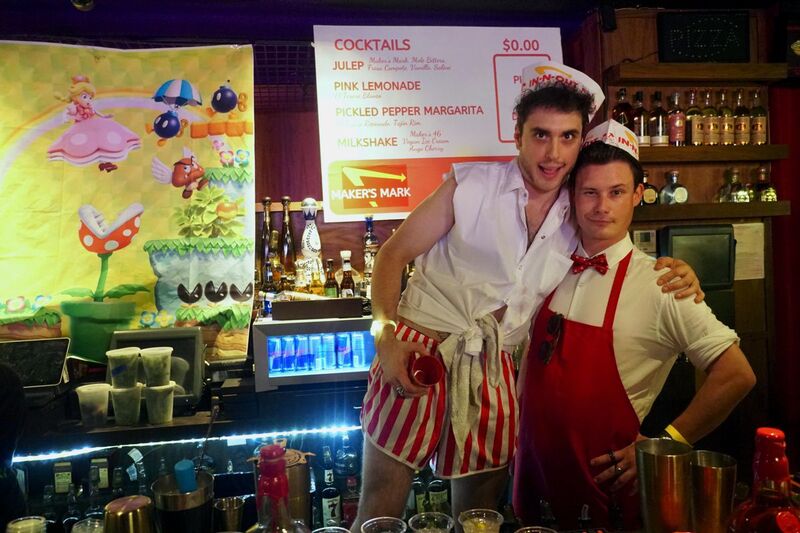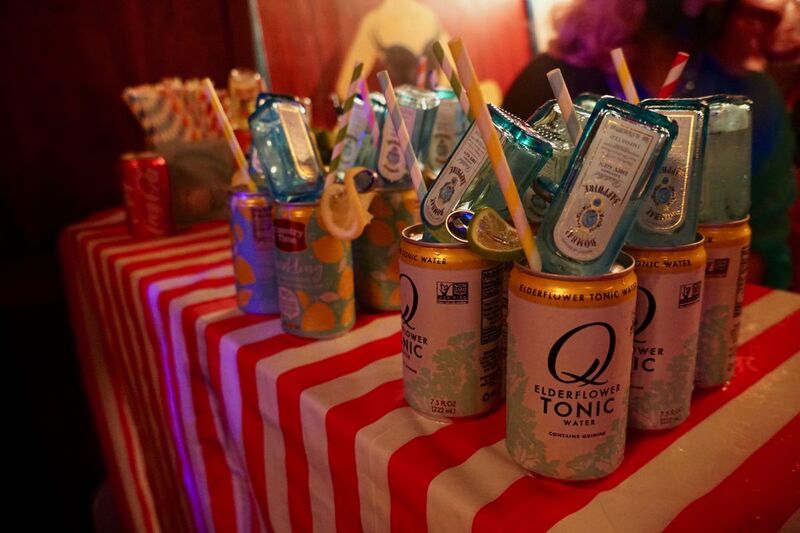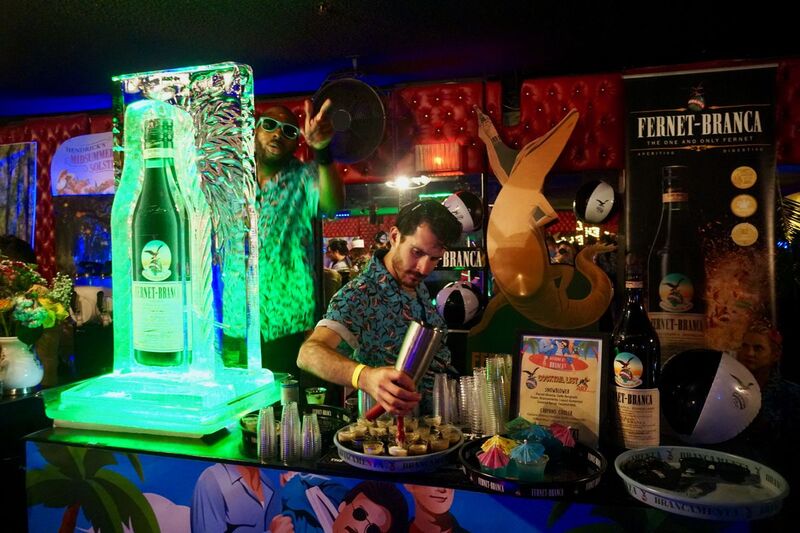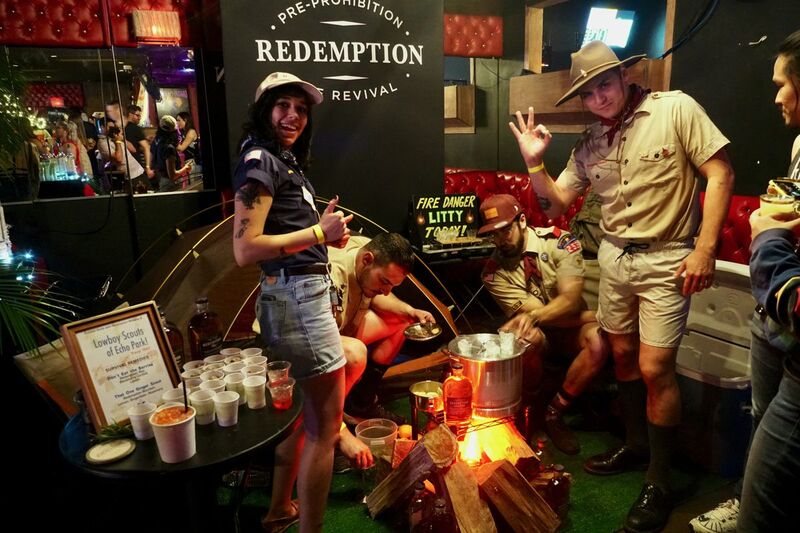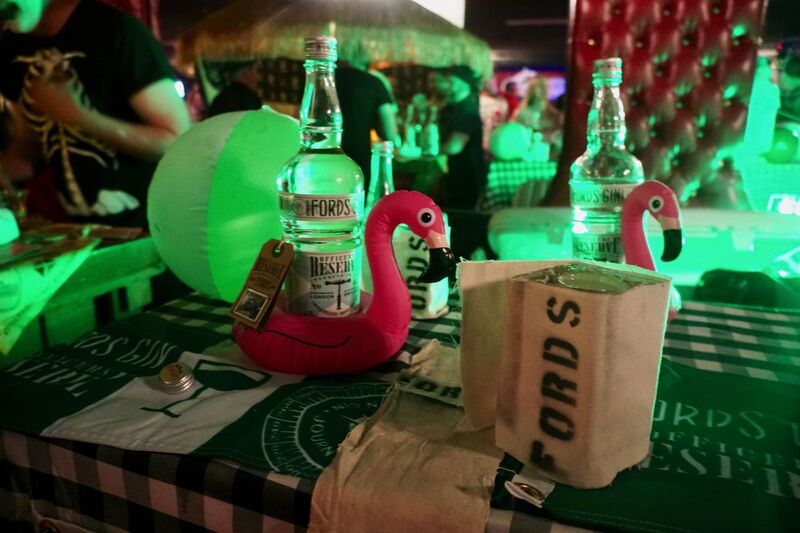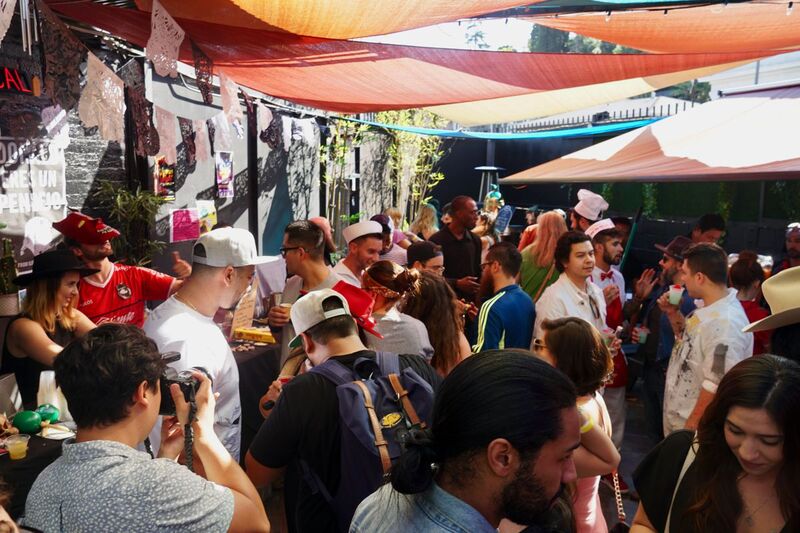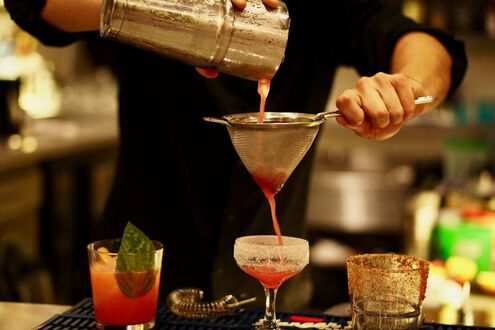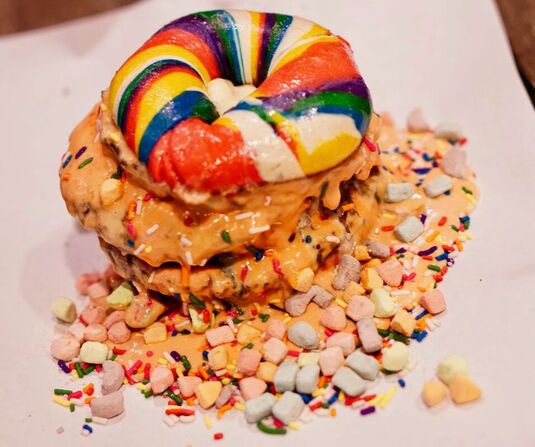|
Art Beyond the Glass saw another successful year, bringing together a lively community of LA’s bar and beverage professionals in electric and ever-so-festive fashion. The annual event, which is dedicated to celebrating the artistic side of bartenders’ lives—literally—showcases painting, music, and all types of performance for a like-minded and rowdy crowd. Throw in endless craft cocktails and vendor experiences that stretch the realm of creativity and you’ve got about as ironically sophisticated take on a college party as you can get. Held in the Los Globos Theater, Art Beyond the Glass welcomed an array of classic and up-and-coming drink purveyors that came ready to cater to their seasoned audience. Hendricks Dry Gin commemorated the event’s timing with a ‘midsummer solstice’ that included a number of summery drinks combined with a fully-costumed [read: scantily-clothed] Puck, emblematic of A Midsummer Night’s Dream. Ilegal Mezcal was back with hand-injected Jell-O shots (yes, they had syringes on hand). Adjacent to them, Tromba Tequila offered up a sinfully sweet alcoholic melon sorbet topped with vanilla tapioca. While Art Beyond the Glass is not necessarily known for food, Marker’s Mark made the day by dressing up their booth as a makeshift In-n-Out and—you guessed it—ordering dozens of In-n-Out burgers for the crowd. Patrons chomped and drank away whilst playing Duck Hunt at the Super Mario Bros setup hosted by Suntory. Ford’s Gin went the extra mile by serving their drinks in gigantic ice blocks. Jägermeister promoted its new Jägermeister Manifest, but only for those who deemed themselves worthy by completing a medieval maze in 2 minutes or less to obtain the key necessary to unlock the libation from its display case. Jack Daniels, which hosted “Lynchburg Crossfit,” served up a drink that supposedly required handstand pushups and burpees to order, but—unsurprisingly—most were able to try it by just asking nicely. On the artistic side, Art Beyond the Glass featured a number of live art creations, a silent auction, and musical performances. Event proceeds benefited Beautify Earth, an LA-based nonprofit dedicated to beautifying communities through public art. Be on the lookout for next year’s Art Beyond the Glass, taking place June 2020. For more information, visit ArtBeyondTheGlass.com.
0 Comments
Big food companies across the country have been hit hard by what can only be described as a serious loss of trust by their consumer base. Coca Cola, Kraft, Nestle and Mondelez [parent company of Nabisco] are just a few food giants that have seen their CEOs resign. Granted, these companies are alive and well and likely to perform just fine moving forward, but their age-old model of mass-scale, low-cost production is not resonating like it did decades ago, back in the day when all you needed at a baseball stadium were hot dogs and nachos. So what does this mean for restaurants? Big things, all revolving around modernization. All consumer trends right now point to the little guy, the mom-and-pop-ish, locally sourced, small-scale production center where business is made up of guests who know and trust the product. To many, ‘big food’ is synonymous with chemicals, additives, fillers and other elements that consumers are sick of putting into their bodies. A growing clientele is ready and willing to pay a premium for ingredients they trust. This means going to restaurants that embody these same qualities. Each of these big food companies has extended great effort in building their product portfolios to include more ‘trusted’ brands. Kellogg, for example, recently purchased RX Bar, the ‘No BS’ protein bar maker, for a whopping $600 million. Why? In all likelihood, to help modernize the Kellogg brand with a product that has clearly resonated with a newer-age clientele. For restaurants, this means you may want to take a look at your menu mix and assess whether your approach truly appeals to your guests today. Does this mean that as a restaurant you should drop everything, revamp your menu and change out your suppliers all at once? Of course not. Coca Cola will never relinquish its soda business because that’s the core of the brand—they’ve simply built onto that brand by acquiring names such as Odwalla and Zico. As a restaurant owner, this means taking a step back, assessing what’s truly at the core of your business, and finding simple ways to modernize so that you can retain your identity while coming across as new and revamped. This may not always be a food-related change. I recently visited what many would call a local dive in Santa Monica. The place was sitting on prime real estate, just steps from the ocean, and served a modest-yet-comprehensive menu of quality food at low prices. A true gem amidst its over-hyped and over-modernized neighbors, but the atmosphere here was akin to a run-down Irish pub. What an outdoor patio and natural light would do to this place! Yes, this would entail a significant remodel, but at the end of the tunnel would emerge a new, improved version of this restaurant that nobody would consider a dive. A transformation like this leads to higher demand, and a resulting lift in the bottom line. This restaurant is the exact kind of seasoned mom-and-pop establishment that stands to benefit the most from an internal assessment and immediate action steps to bridge the gap between product offering and consumer needs. Moving the focus back to the menu, if you see that an item, or even an entire category, isn’t selling like it used to, then it’s time to revise the ingredient mix or even just your guests’ overall perception. If you hand-grind your burger meat and roll the patties daily, then promote the heck out of that process by detailing it on your menu and table collateral. If you source locally, make sure your guests know. If you notice that more and more guests are subbing out American cheese for gouda, then you’ve found a good replacement or upsell opportunity. The list goes on. If big food companies relied on classic soda flavors, ready-made mac ‘n’ cheese and processed snacks now like they did ages ago, they’d be going the way Sears and K-Mart have gone by not innovating with the rise of online retail. To put it bluntly, it’s just a matter of getting with the times, but thankfully it can be done quite handily. It’s all a matter of observation and small steps to follow what your guests are looking for. Next time you’re at the grocery store, browse through some of the healthier brands you’ve become familiar with and look to see if you can find a name like Mondelez or Kellogg nestled on the package. Another example of small steps and necessary modernization. The art of plating has gone hand-in-hand with the craft of cooking for ages, but presentation is more important as ever in the restaurant world. The reason why can be summed up with a simple, yet alluring phrase: free marketing. As rude as it may be at times, guests that obsessively photograph their food at the table are essentially handing you cash every time they snap and share a picture. Social media marketing can cost you big time; CPM [cost per mil, or cost per thousand impressions] may only be a few dollars, but think about how often guests can share photos of your food, to all of their friends and followers. If you want to reach the same number of people, those dollars add up fast. With this in mind, some restaurants may want to encourage people to post their food photos on social media. There’s a few fun ways to do this… Make your food beautiful Seems like a no-brainer, but food that’s pleasing to the eye will not only be viewed as more delicious, but will inspire guests to take out those smartphones. No ingredient changes needed; all that may need to be done is some simple rearrangements on the plate. Follow some simple steps to do this:
Add color, depth and height Just like any piece of artwork, food is enhanced with color. Radishes, carrots and herbs are easy ways to add vivid color to many savory dishes. A contrasting sauce, dabs of oil across the plate or a smear of spread are more common practices that chefs employ. Depth and height are catalysts for social media-worthy food. Fries stacked log cabin-style, rack of lamb with crisscrossed bones and sandwiches with one half peeking over the other are all methods to add something special to traditionally two-dimensional items. Use interesting plates and glassware If you’re in the market for these materials, you may consider spicing things up beyond the basic circular plate and tumbler glass. Serving items that allow photos to capture more food and less ceramic are always preferable. Asymmetrical bowls, for example, can help capture photos of soup and salad. Specialty cocktails in specialty glasses command a premium presence. Keep aspect ratios in mind For the non-photographer, aspect ratio is the photo’s width-to-height ratio. Instagram, for example, works using square photos, or a 1:1 aspect ratio. This means that ‘rectangular’ items, such as three sliders and a basket of fries presented in one long row, are difficult to fit within the frame. A chef may want to consider presenting the sliders in a triangular pattern with the fries in the center or on one side. Beer flights are another example. Bars will often serve beers in one long row, whereas shifting to a more square display cold capture more of the product in a shot. Own a hashtag Perhaps most important in your efforts to create a social media buzz is being able to monitor the results. How else are you going to know if the time and energy you’re dedicating is paying off? Come up with a hashtag and promote it around your restaurant—entryway, menus, table tents, receipts and other touch points are all prime real estate. Keep the following in mind when creating a hashtag.
By encouraging guests to use your hashtag when posting, they’re self-sorting their posts directly into a virtual folder that you can open up and monitor whenever you want. This approach to marketing is free and convenient…not a common find. Then there’s the idea of creating social media contests to promote this marketing effort even further. That, however, is a conversation for another time. |
AuthorBenjamin Brown is a seasoned restaurant writer and hospitality consultant, serving up SoCal's hottest food news and reviews. Categories
All
Archives
June 2021
@Foodie_Biz |
|
Home
About
Blog
Consulting Tips
Contact
Legal
|
Foodie Biz provides restaurant news and reviews for the food community, as well as consulting advice for restaurant owners and other hospitality professionals.
Contact Foodie Biz for media opportunities and freelance consulting projects. Contact Foodie Biz |


